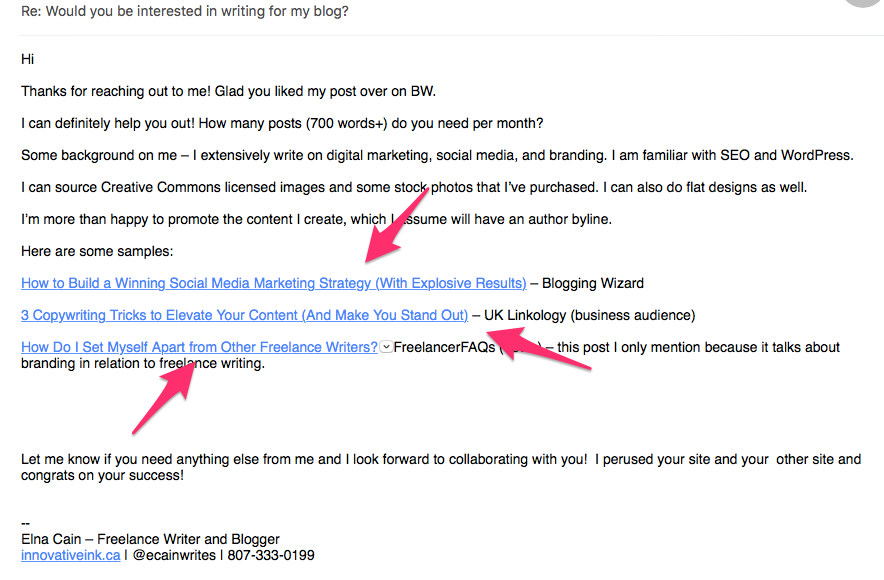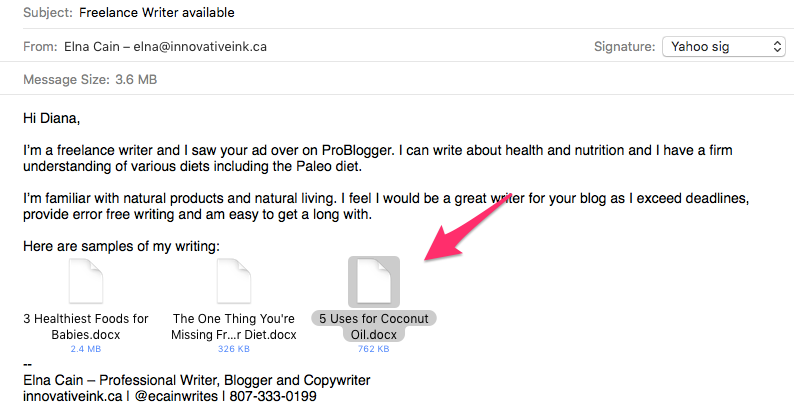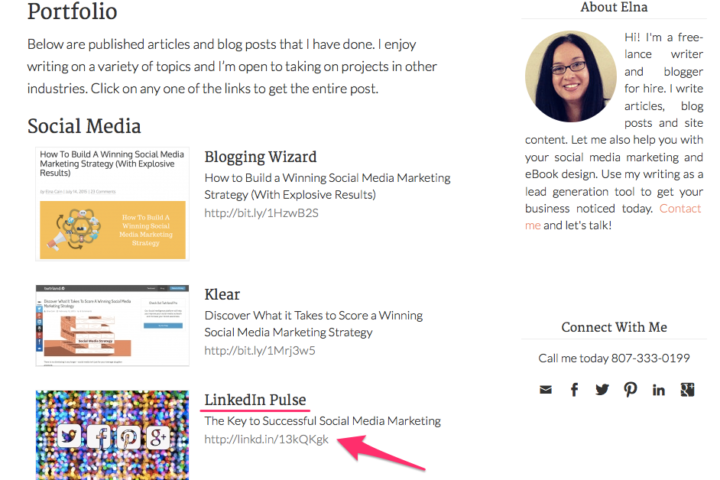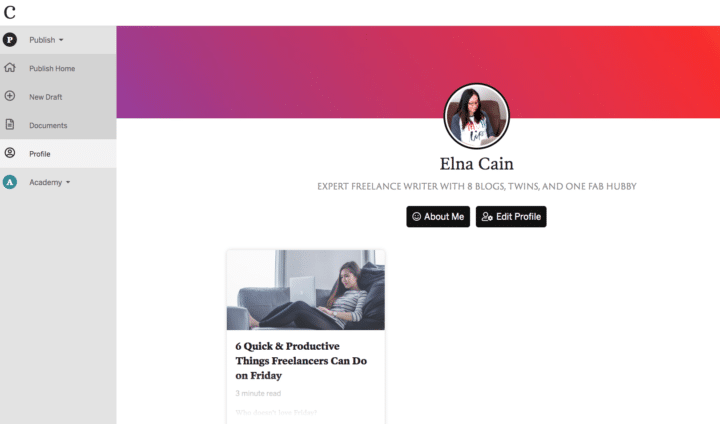Raise your hand if you’re a journalist and any writing portfolio pieces you have are in print?
You want to transition or moonlight as a freelance writer, but you have no proof online that you can even write.
You’re stuck and have no clue what to do, even though you have years of reporting background or experience writing news stories for your local newspaper.

This story isn’t uncommon.
I’ve learned there are many talented journalists with extensive backgrounds and training, but have no way of showing this online.
What do you do in this case?
Let’s look at traditional ways you can build your freelance writing portfolio and then I’ll show you two obscure ways to create writing samples from scratch (with an actual link you can show prospects that you do have published material online).
Freelance Writing Portfolio – Where Writing Samples Live
There are a few traditional ways new freelance writers create samples for their freelance writing portfolio.
But, even though they are the standard, they aren’t always the best approach if you’re a journalist.
1. Your Blog Posts
One of the easiest ways to create writing samples for your freelance writing portfolio is to just create blog posts on your writer website.
You can create sample pieces of content you want to get paid to write about.
For example, if you want to write and get paid for career topics, then create a few blog posts in that niche.
It doesn’t really matter what you blog about really, since prospects are looking to see if:
- You know how to write for an online audience
- You provide quality content
- Your writing is easy to read
- You engage the audience in your writing
What’s great about this is, after you publish your posts, you have a link for your portfolio page.
But, what if you don’t have a blog or even a writer website?
You’re a journalist and want to break into online writing, but without a website or a blog this is a little more difficult than you originally thought.
What then?
2. Guest Post
By far, the best way to build your portfolio is by guest posting.
You not only get a link for your freelance writing portfolio, but you also get your name out there (and it’s on someone else blog!).
It’s a great marketing strategy since you get an author bio at the end of your post.
This can help you land clients, or at the very least, get prospects back to your site or your freelance writing portfolio page – if you have it on a free portfolio platforms such as Contently or Pinterest.
But, guest posting can take a lot of time out of your schedule. You have to:
- Research which blogs accept guest contributors
- Find out if those blogs are worth your time (i.e. are the sites popular, does the blog produce epic content, what’s their content schedule and time frame for publishing guest posts)
- Make sure you thoroughly read the guest contributor guidelines
- Pitch your idea or draft
- Write the guest post
- Wait to see if it’s been accepted
And when you do land a guest post, most blogs have a long wait time from the time you submit your post to the actual publication date. This can span anywhere from 2-6 weeks.
But, you need to create writing samples now. You want to pitch and to pitch you need sample posts to show prospects you can actually write.
What do you do now?
3. Create Your Own Writing Samples
A final way to build your freelance writing portfolio is to just create writing samples yourself.
It’s super easy and for journalists – while it might be time consuming – you can transcribe your print material to a MS Word document easily.
You can also create a Google Doc and make a shareable link. You can then link this in your portfolio.
But, this isn’t the best way to showcase your work. For starters, if all you have are PDF’s for samples, it makes you look amateurish. Let’s take a look at a pitch email and tell me which one looks more professional.
This one with links to my portfolio pieces:

Or this one:

The second one screams you’re a new freelance writer.
And you know what?
If a prospect gets a whiff of your newbie smell, they might get scared and move on to a more experienced freelance writer’s pitch email.
Prospects need to know you are a professional and this is your thang!
They are entrusting your with their content marketing strategy to help them generate traffic, sales and loyal customers or readers. If you’re new, they might think you have no clue how to do that.
But you and I both know you DO know, because you’ve been doing this for years…just in print.
If you provide documents or PDFs of writing samples, it just means you are not an online writer.
You are a writer and documents are all you have! So, how can you solve this?
Freelance Writing Samples – 2 Free Methods
Traditional ways just aren’t working for you and you need a way to build your freelance writing portfolio with online content.
You don’t have a website or blog yet, but you know you want to at least start pitching and seeing if this is actually a viable career (which it is!).
Well, there are two simple and great ways to create online writing samples without a website or blog and without guest posting. Let’s look at them in detail.
1. Use LinkedIn Pulse to Create Writing Samples
Do you have a LinkedIn profile? I hope you do.
It’s the place for professionals to network with others in their industry and it’s also a perfect place to land clients.
LinkedIn has a publishing platform, LinkedIn Pulse.
It’s a place to read the latest news from influencers and other professionals.
It’s also perfect to create your writing samples.
To do this, you first need a LinkedIn profile (it’ll come in handy when you’re a freelance writer!).
Once you filled out your bio and added your experience, you can start publishing content on the Pulse.
On your home page, click on, “publish a post.”

You then have a place to start writing your first sample. Include a feature image by sourcing Creative Commons licensed photos.

When you’re done, you have your first online sample that you can share on social media, add to your portfolio and provide in your pitch.
This is what I did when I was new to freelance writing.

2. Use Contena Publishing to Create Writing Samples Easily
The final place you can score an online sample is using Contena Publishing.
It’s a job board and a publishing platform. Win-win!
When I was trying to find ways to create writing samples, I learned about this platform and this is what sparked this blog post.
You can write content, link to your blog posts or share them on social media.

Just like the Pulse, you can instantly begin typing your sample and adding images to complete your post. You now have another sample you can link to in your portfolio.
While both of these platforms can act as your portfolio, I strongly suggest you use your writer website to house your samples.
And if you don’t have a website yet, then to use Contently.
For more help, checkout the Writing Sample Starter kit!
Build Your Freelance Writing Portfolio Today
You don’t have to wait weeks to see your first sample. You don’t even need your own blog.
By using publishing platforms like the Pulse and Medium, you have an easy way to draft up your sample pieces and have them instantly published online.
So, what are you waiting for? Publish a post on the Pulse and sign up to Medium (if you haven’t already) and start writing!
But, if you need more help on sample writing, here’s my guide to how to write a sample for your portfolio.
If you follow me on Twitter, make sure to tweet your first sample and share it on LinkedIn so I can see it!





69 Comments